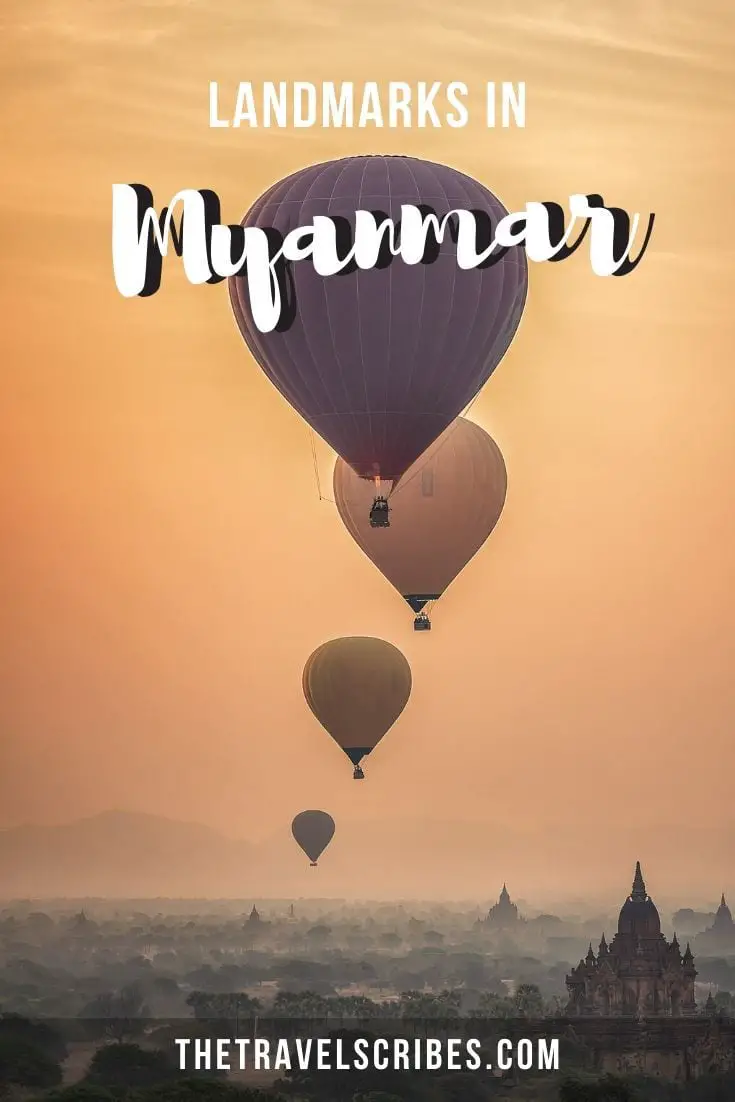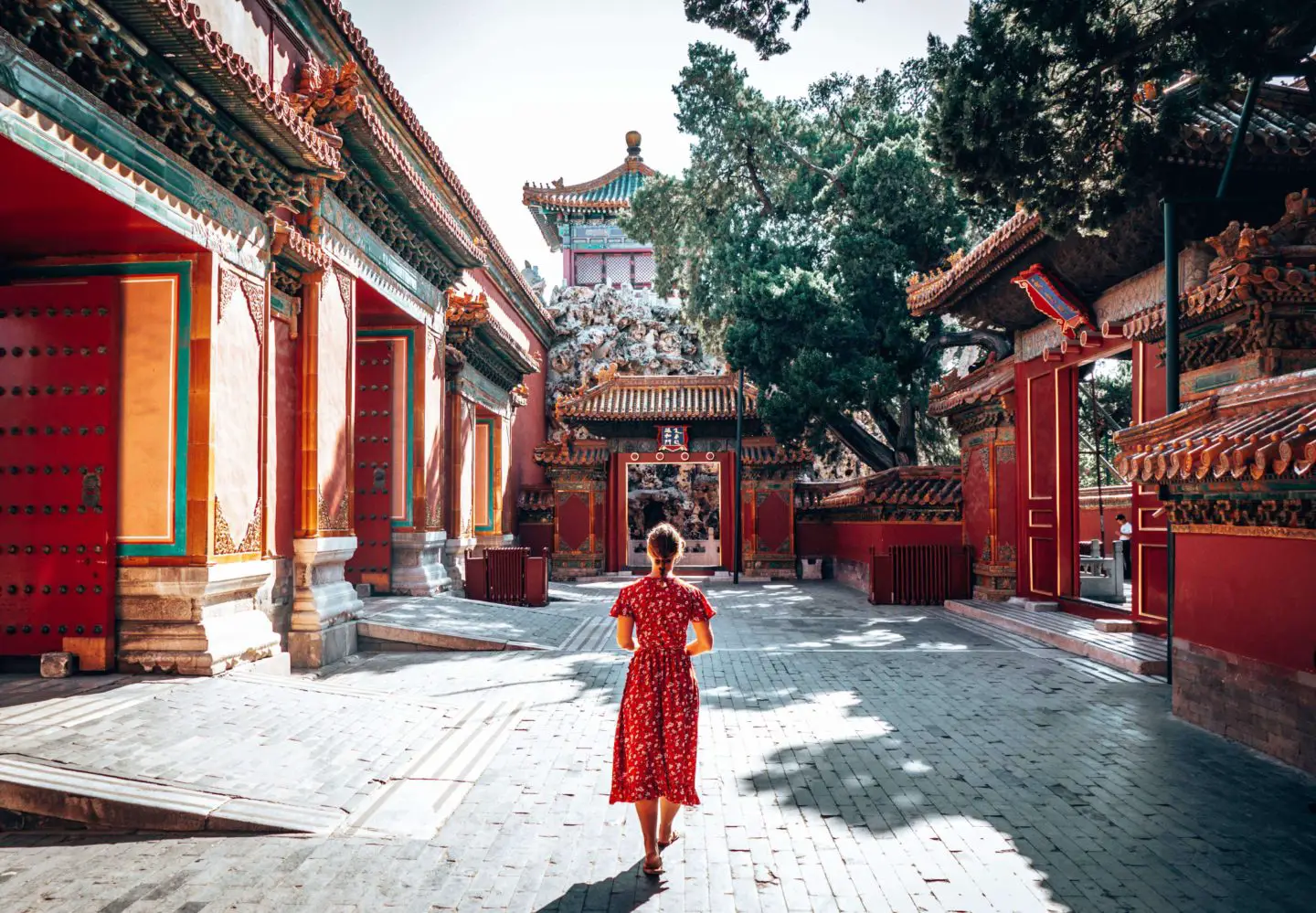From golden pagodas glistening in the sunlight in Yangon, to forgotten temples on desolate desert plains in Bagan, Myanmar is a country crammed with incredible beauty, iconic monuments and a history undoubtedly worth exploring. To bring together the best that the former country of Burma has to offer, we asked leading travelers to help us count down the most iconic places and landmarks in Myanmar.
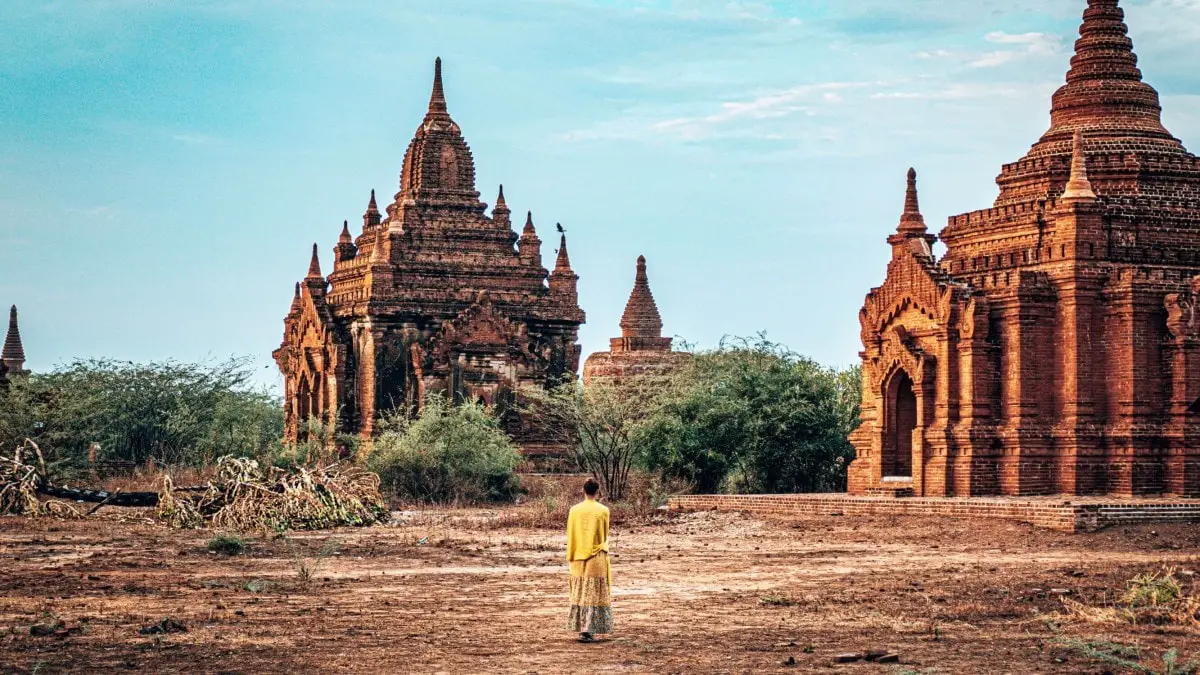
Skip ahead
The top 10 landmarks in Myanmar
- Bagan Temples, Bagan
- Shwedagon Pagoda, Yangon
- U Bein Bridge, Mandalay
- Inle Lake, Nyaungshwe
- Mandalay Hill, Mandalay
- Mingun Pahtodawgyi, Mingun
- Mahamundi Buddha Temple, Mandalay
- Mount Popa
- Hsinbyume Pagoda, Mingun
- Kuthodaw Pagoda, Mandalay
Bagan Temples, Bagan
Explored by Elisa from World in Paris
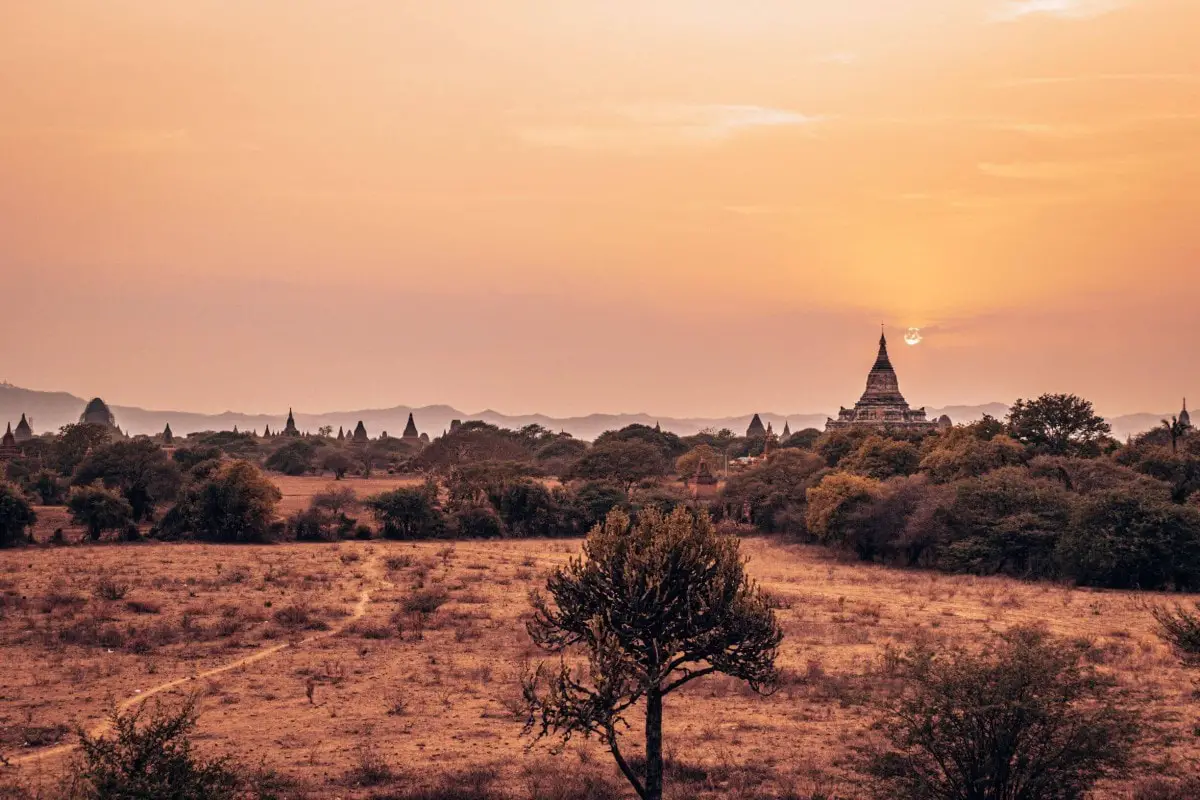
Bagan (and the temples dotted around it) is probably the one of the most famous Myanmar landmarks. This ancient city, best known for its stupas and pagodas, is located in the region of Mandalay, 600km North West of Yangon the capital.
The ancient city, considered a ‘treasure’ of Myanmar has more than 2, 800 Hindu and Buddhist temples and pagodas sprinkled across it’s plains, some dating back as far as the 9th century. But, more than that, the city – like Turkey’s Cappadocia – also has hundreds of hot air balloons floating up above the temples at sunrise, making it a spectacular sight.
Temple-hopping is definitely the activity of choice in the town as travellers usually rent e-bikes to get around the dusty roads. It used to be that you could also climb the temples but the government put restrictions on this in 2018, so its best to consult other travellers or government websites before attempting to do so.
Related: The ultimate list of landmarks from around the world!
Mount Popa
Explored by Lee from The Travel Scribes
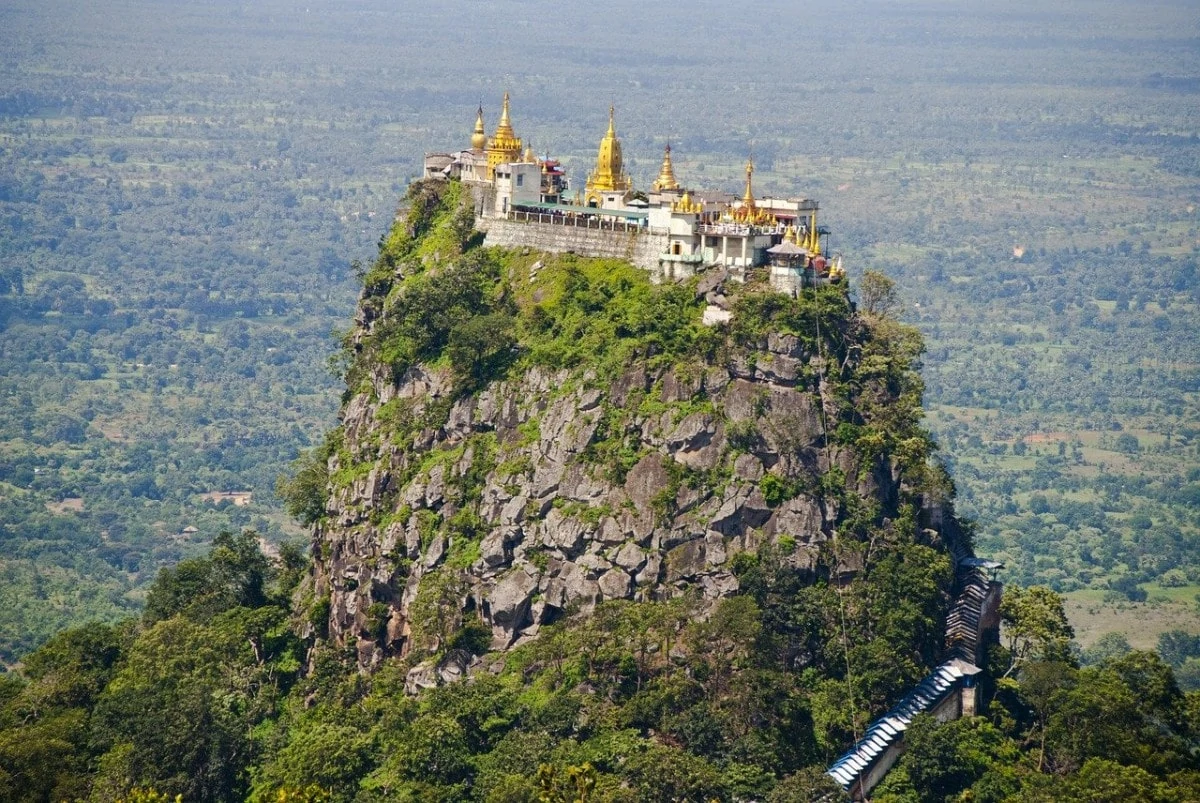
Situated about 50km from Bagan is a little-known Burmese landmark, Mount Popa. This extinct volcano reaches over 1500 metres (4980 feet) above sea level and is part of the Pegu Range. Actually you can see this gorgeous mountain from as far away as the Irrawaddy River (Ayeyarwady River).
But Mount Popa is more than just a soaring mountain made of basalt and andesite lava flows: it’s a pilgrimage site. That’s since atop the mountain sits the Popa Taungkalat Shrine, a monastery and temple worth the trek for the temple but also the views. The pilgrimage up to the shrine can only be done via the 777 steps that lead up to it, which must be done in bare feet – all shoes and socks have to be removed. Also, keep in mind that the temple has quite a number of slightly assertive monkeys so try not to take any food up with you (and pack some wet wipes to clean your feet after the walk!).
U Bein Bridge, Mandalay
Explored by Bella from Passport & Pixels
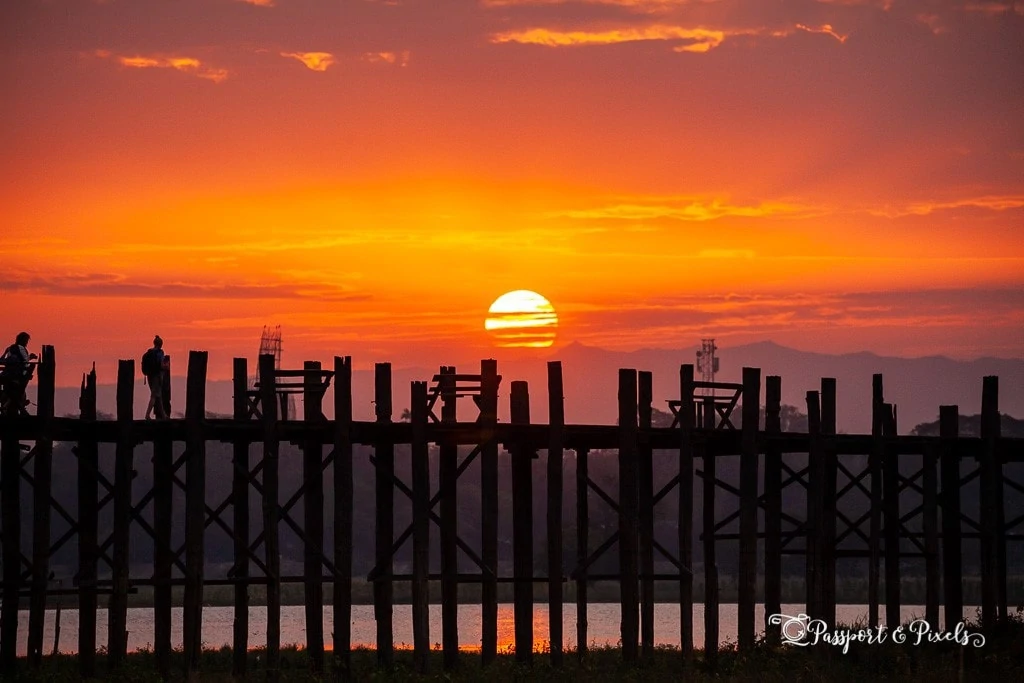
If you’re planning a trip to Myanmar you’ve probably already seen photos of U Bein Bridge, even if you didn’t know what it was. The ancient bridge, silhouetted against a sunrise, its rustic wooden supports reflected in the water – it’s an entrancing image. So it’s probably no surprise that alongside Bagan and Inle Lake this is one of Myanmar’s most iconic places to visit and one of the landmarks in the country.
U Bein Bridge is a teak bridge about 30 minutes drive outside Mandalay. It was built in about 1850 and at 1.2 km long is believed to be the oldest and at one time the longest teak wood bridge in the world. It has 1086 wooden pillars that stretch across the Taungthaman Lake, and today it’s still used as an important crossing by local people.
Unfortunately, due to its status as a major attraction, it’s also become something of a tourist trap, surrounded by stalls selling souvenirs. But it’s still a lovely place to see and wander round for an hour, taking in the view and the atmosphere.
The best time to visit is just before sunrise, when most people are still asleep. Dragging yourself up that early may be painful, but worth it to avoid the crowds and get that glorious sunrise shot. When you get there, resist the urge to make straight for the bridge itself – you can’t take a photo of it while you’re standing on it! This is what the rest of my group did – you can see them in the photo – and I think I was the only person who walked AWAY from the bridge to get the sunrise with the bridge in the shot!
Bogyoke Aung San Market, Yangon
Explored by Oksana & Max from Drink Tea & Travel
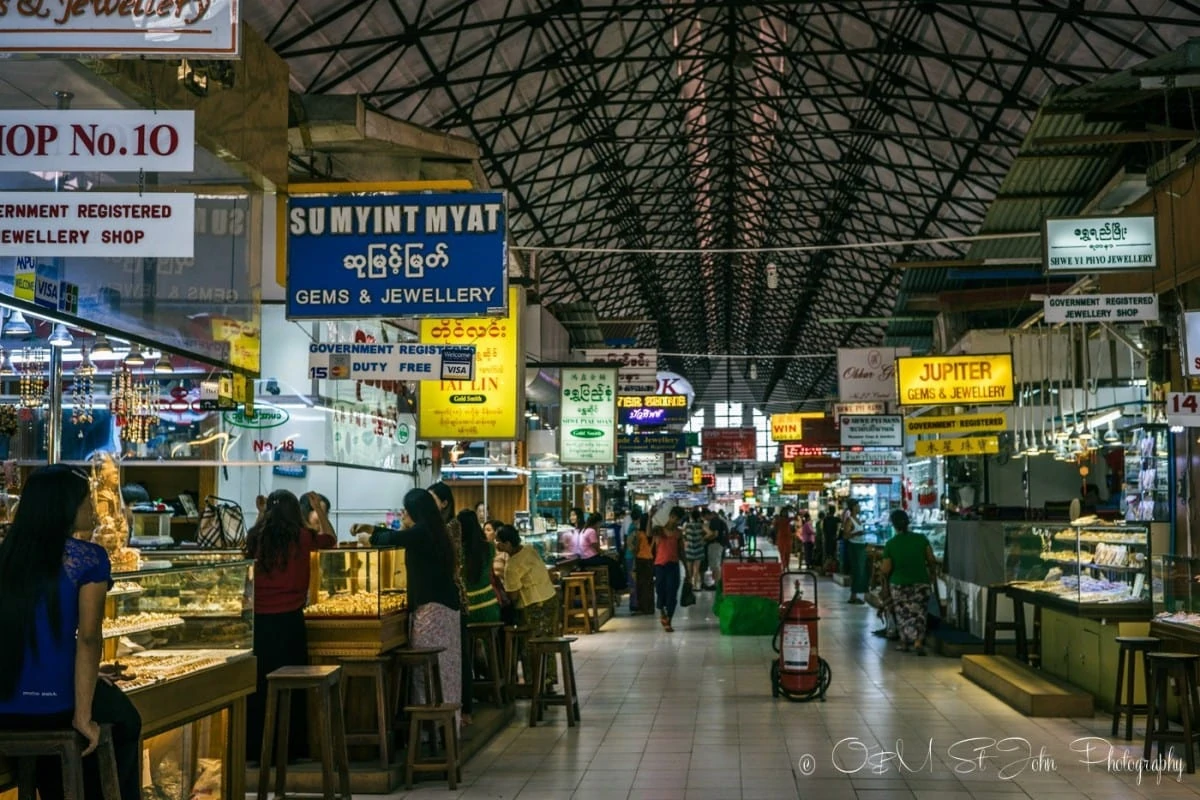
Taking the time to explore Bogyoke Aung San Market should be at the top of your list of things to do while visiting Yangon. This market is known as a major trading destination famous for antiques, Burmese handicrafts, jewellery shops, art galleries, and clothing stores.
It is located at the end of Shwe Bon Thar Rd and was formerly known as Scott’s Market. It was named after the Commissioner at the time of its opening. However, that’s not the only reminder of British rule in Yangon. The building is known for its cobbled streets and colonial architecture which has landed it a spot on Yangon’s Heritage Building List.
Today, the market is largely geared towards tourists. Stock up on the local fashion must-haves (i.e. the longyi) and sample some great local street food; definitely try the papaya salad and freshly squeezed orange juice from the many vendors within the bazaar.
If you are after textiles, you can find colourful works from hill tribes on the upper level of the market. Buying from these local vendors helps the local economy and ensures you’re bringing home authentic souvenirs from Myanmar!
Mahamundi Buddha Temple, Mandalay
Explored by James from The Travel Scribes
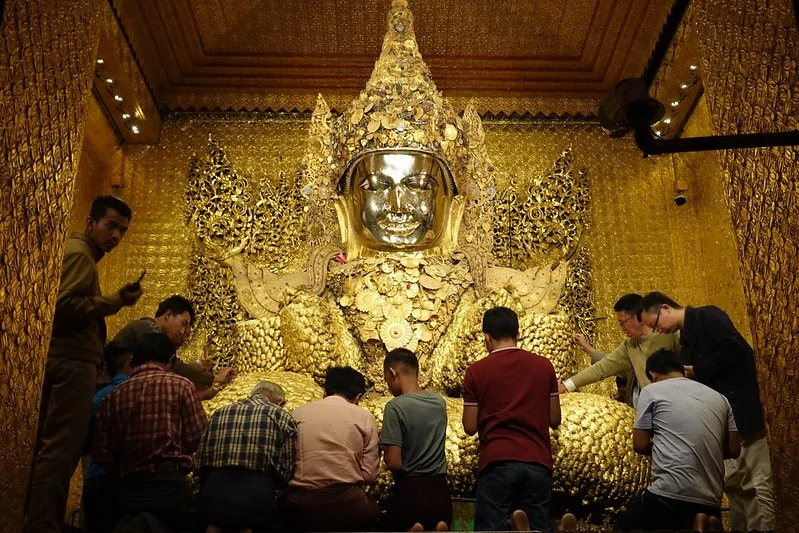
Photo credit: Richard Mortel / Flickr
Nestled between 82nd and 84th street in downtown Mandalay, the Mahamundi Buddha temple is one of the most important Buddhist sites in the country, and is home to the Mahamuni Buddha image, the most revered in the nation.
The temple was built back in 1785 by King Bodawpaya from the Konbaung dynasty and today houses the temple and pagoda, along with a museum dedicated the history of Buddhism.
The Mahumani image itself is in its own chamber, seated on a hugely ornate pedestal and measuring nearly 4 metres high. The Buddha image practically glitters, as male visitors to the temple can apply gold leaf to it, in a ritual called ‘shwe cha’, which is offset by its spectacular crown featuring diamonds and rubies.
If you really want to witness something special, each morning at 4.00am the Buddha image is washed by a senior monk who, along with some helpers, washes the face and brushes the teeth of the Buddha image.
Shwe Yan Pyay Monastery, Nyaung Shwe
Explored by Jing Calonge of Finding Jing
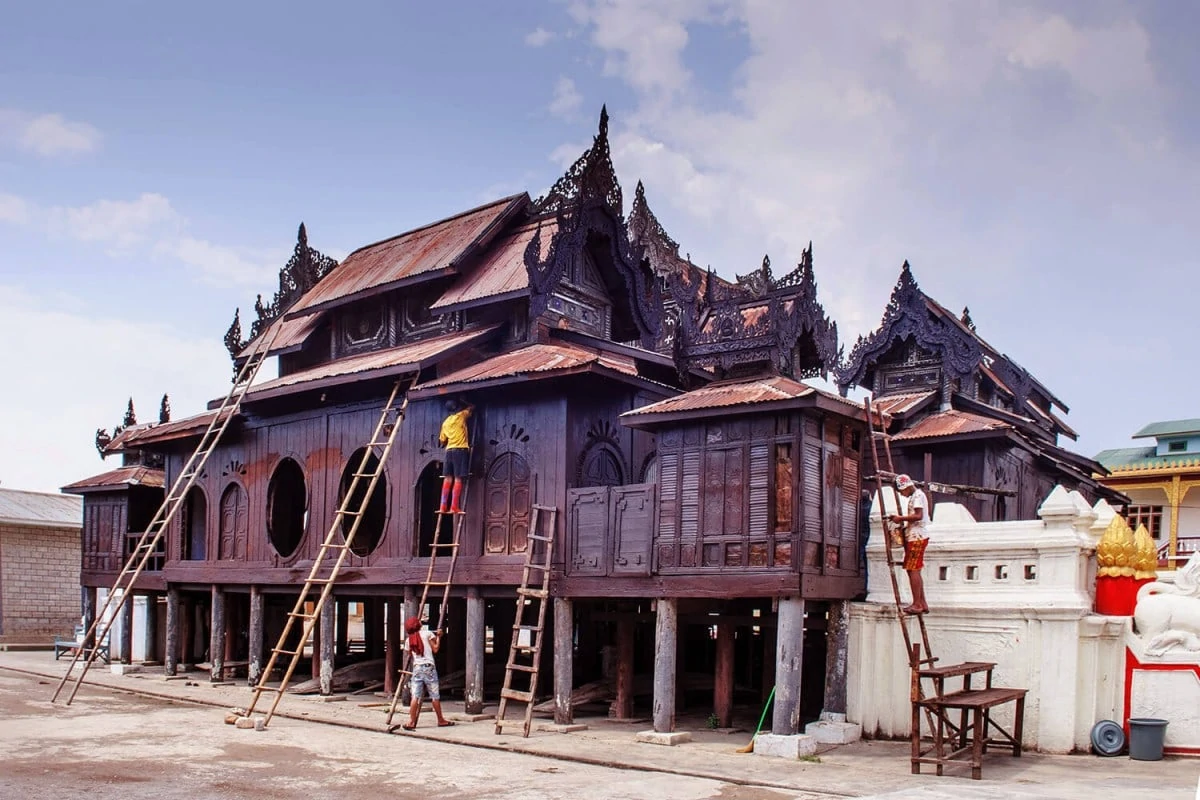
Travellers heading to the popular Inle Lake often make their way to Nyaung Shwe Township and, while there, definitely shouldn’t miss the Shwe Yan Pyay Monastery.
Built about 150 years ago out of sturdy teak wood, this red-painted structure is striking although not very extravagant, as is normally seen in royal Burmese monasteries and pagodas. What Shwe Yan Pyay lacks in extravagance, it makes up for its noble intentions, as it was initially created to serve as a home to underprivileged boys in the region. Here they were provided not only with shelter but also food and education, with many trained as novice monks.
What makes this monastery an iconic structure is the distinguishing large oval windows. These huge framed windows are so gigantic they almost seem like doors, and make for a great photo opportunity as you see young saffron-clad monks from the windows while going about their daily activities.
Shwe Yan Pyay Monastery is located roughly 2.4 kilometers from the Nyaung Shwe town center and is open from 8.00am – 6.00pm. You can flag a taxi to get there but its worth traveling green by foot or bike, especially since the road to the monastery is flanked by towering trees and offers a spectacular view of the tranquil Tharzi Pond.
Mingun Pahtodawgyi, Mingun
Explored by Wendy Werneth of The Nomadic Vegan
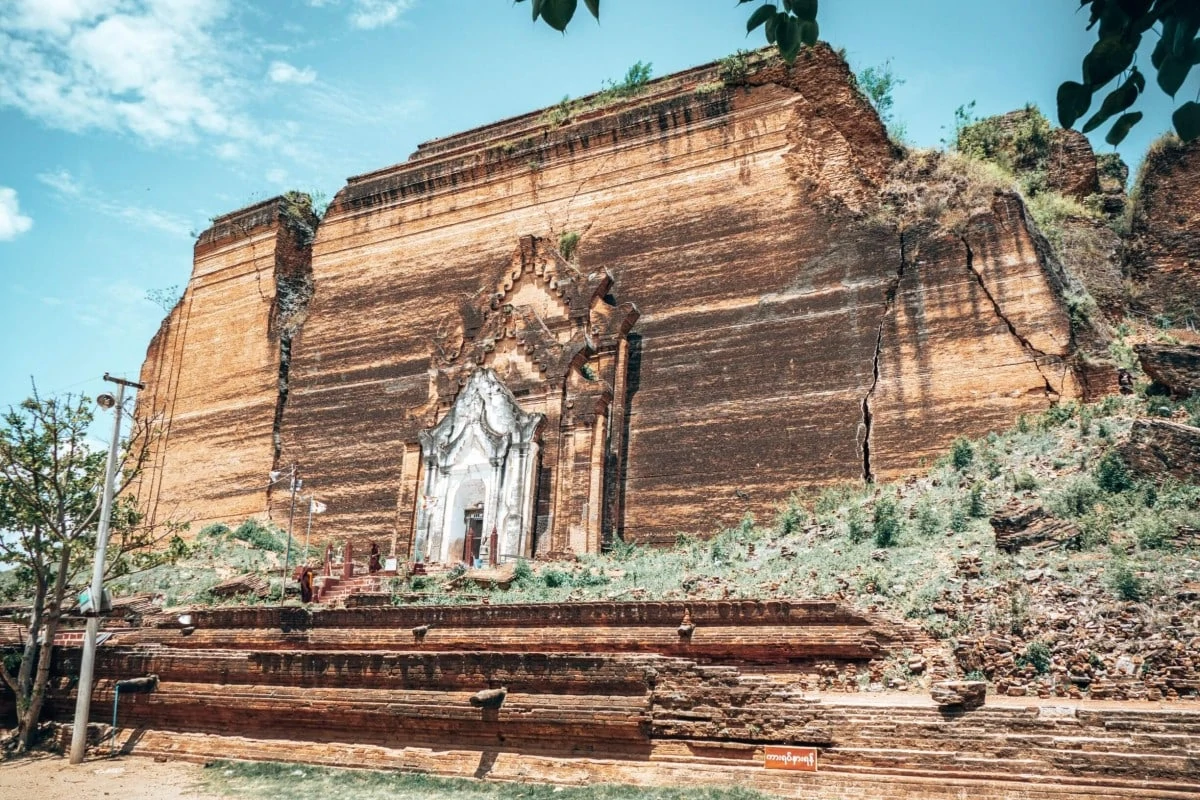
The word “Pahtodawgyi” means “Great Stupa”, and it’s certainly an appropriate name for this colossal structure. From afar, it looks like a sandstone mesa. It’s only when you get close that you realize what you’ve been seeing is actually manmade.
Construction of the stupa was started by King Bodawpaya in 1790, and it was left unfinished on purpose. Some say that this was because the building project simply became too expensive and funds ran out. However, according to folklore, a prophecy foretold said that as soon as the stupa was completed, the country would be destroyed. The King was a very superstitious person, so he slowed down the construction effort. Then once he died, the project was abandoned.
If completed, the stupa would have been a staggering 150 meters tall. What we see today is only one-third of that height, and even so, it’s still mind-boggling. The huge cracks splitting through the façade are the result of an earthquake that hit in 1839. Nearby, within the Mingun complex, is a miniature version known as the Pon Daw Pagoda. This shows what the stupa would have looked like if it had been finished. What we see of Mingun Paya today is basically just the square base, and above that would have been a huge bell-shaped structure that tapered to a point at the top.
Fun fact: The unfinished stupa holds the record for being the largest pile of bricks in the world! Now imagine how big it would be if the stupa was actually completed…
Kyaiktiyo Pagoda
Explored by Lee from The Travel Scribes
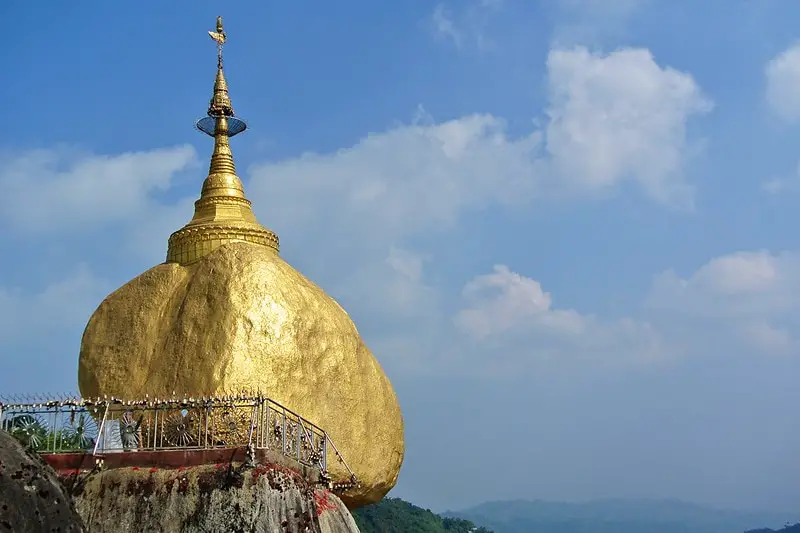
Photo credit: James Antrobus / Flickr
It looks as if its about to fall and crash to the ground below it but somehow – just somehow – the Kyaiktiyo Pagoda manages to stay put. This pagoda, also known as the Golden Rock, is a gold-lead covered stone perched on the edge of a cliff in the Mon State.
Measuring 25 feet high and 50 feet in diameter, legend has it that a hermit gave a strand of hair to the Buddha, which he gave to the King. In return, the King bestowed the boulder as a gift to the hermit, using magic to pull it from the depths of the ocean and up onto the hillside. The king then built a small pagoda on top of the boulder to showcase the hair, and encourage pilgrims to visit it.
And many pilgrims still do, with a peak visiting time in March during the Full Moon, where nearly 100, 000 candles are lit to illuminate the massive rock at night.
Uppatasanti Pagoda, Naypyitaw
Explored by Iris from Mind of a Hitchhiker
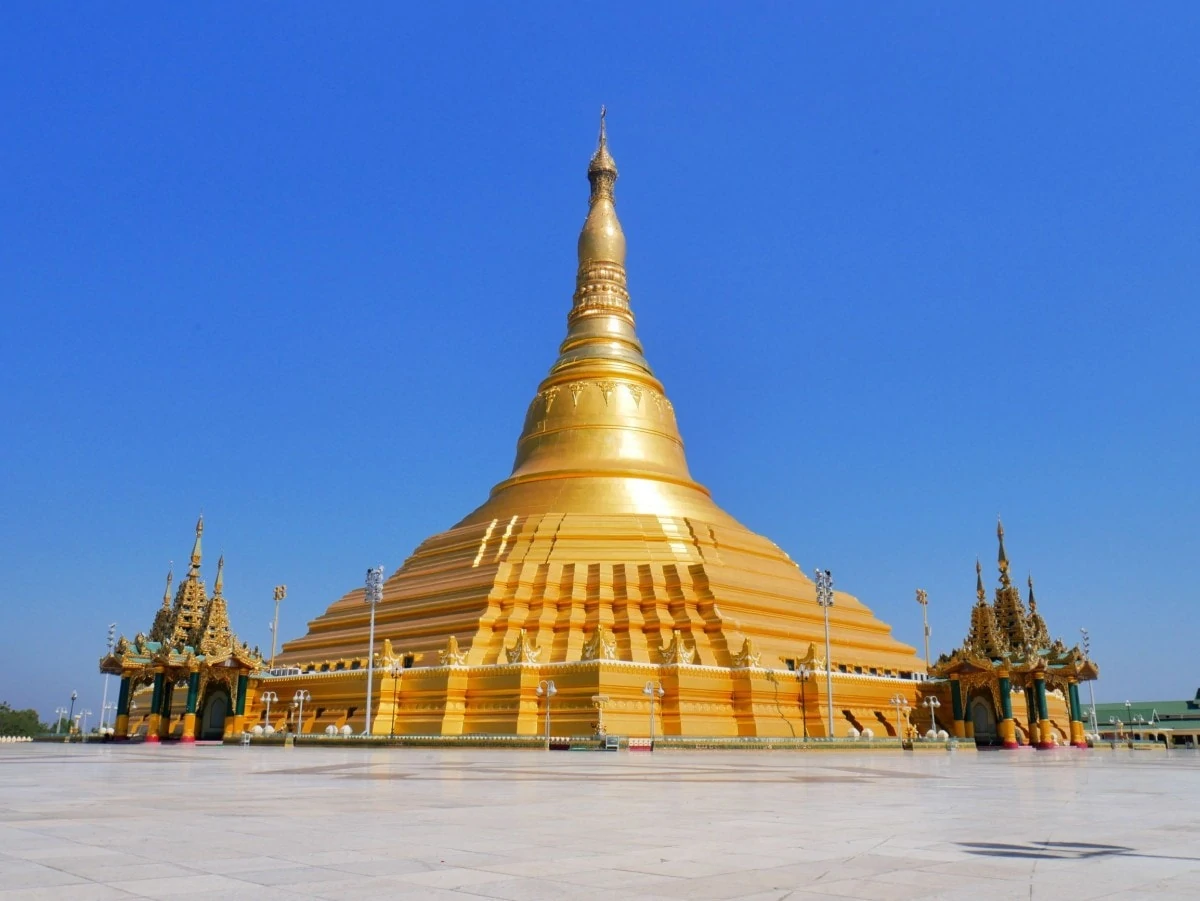
Naypyitaw is a completely planned city that replaced Yangon as the capital city of Myanmar in 2006. It’s a peculiar place to visit for those interested in urban planning, and often the target of derisive comments. Naypyitaw’s most iconic landmark is the Uppatasanti (Peace) Pagoda some 15 kilometres away from the Hotel Zone. Its design is copied from the more sacred Shwedagon Pagoda in Yangon, but that doesn’t make it any less beautiful. In fact, it’s actually quite unique in many ways that are not about its design.
Built from 2006 till 2009, it’s a very new pagoda that stands an astonishing 99 meters tall and harbours a Buddha tooth relic. As there’s not much yet in Naypyitaw, you can often see this gilded beacon of Buddhism from afar across swathes of undeveloped land. Older articles on the web will tell you that there are no monks in Naypyitaw, but as of 2020, that’s not true anymore.
Getting to Uppatasanti Pagoda can be done by arranging a taxi from your hotel or by renting a motorbike for a day trip around Naypyitaw. Entrance to the temple grounds is free of charge, and you may even enter the dome—unlike at the Shwedagon in Yangon. As there are almost no tourists visiting Naypyitaw, chances are good that you’ll be the only tourist visiting this marvel. If you take a taxi, make sure it’s a return trip since there is no Grab in Naypyitaw and there are virtually no free-roaming taxis to hail.
Mandalay Hill, Mandalay
Explored by Lee from The Travel Scribes
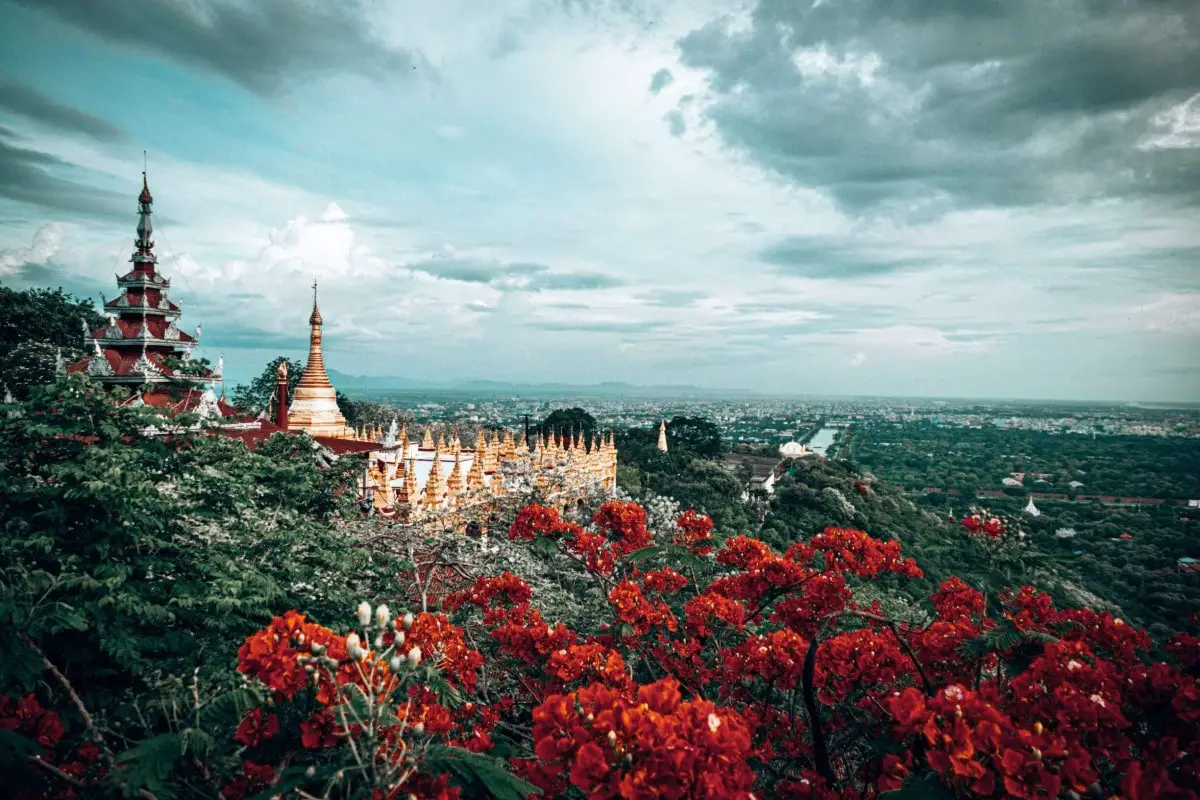
Towering over the city of Mandalay, Mandalay Hill is one of the top tourist attractions in the city. With Mandalay a particularly flat city, Mandalay Hill is a huge focal point – rising 760 feet into the air it’s not only a large Myanmar landmark in itself, but also home to a number of monasteries and convents that you can visit.
The journey up to the top of the hill can be done by car or by foot, with the climb taking about 30 minutes. However, since you pass through a number of temples, much of the walk has to be done barefoot; something to keep in mind before tackling this iconic place.
The crowning glory? Definitely the Sutaungpyei Pagoda. Sitting atop the hill this pagoda offers unrivalled views of Mandalay and the Ayeyarwaddy River but also a beautiful tiled patio where you can wander around and take a number of gorgeous snaps. Best enjoyed at sunset you’ll also find a number of young monks frequenting the pagoda, eager to strike up a conversation with tourists to get in some English language practice.
Sagaing
Explored by Soumya from Stories by Soumya
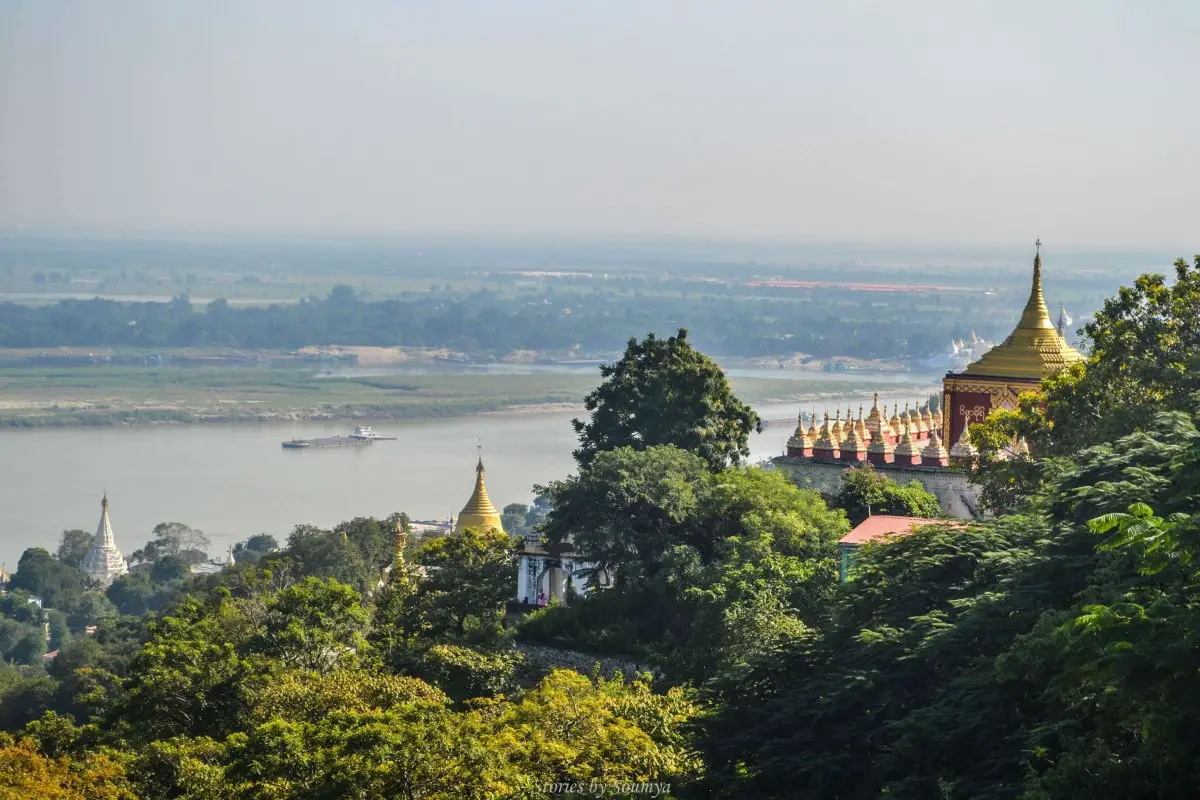
Sagaing, a small town located among lush green hills surrounding the River Irrawaddy is one of the most iconic places to visit in Myanmar. The town has one of the prettiest skylines in the world. Yes, a skyline dotted with golden, silver, and white pagodas popping out of picturesque green hills. Isn’t that such a pretty sight?
Sagaing has always been historically important. Because of its location on the Irrawaddy river, it held great strategic power in the olden times and was the capital of multiple Burmese kingdoms. Consequently, it became home to more than 300 religious buildings – big and small. Today, it is an important centre for Buddhism in Myanmar as devotees come to pay homage to Buddha at these shrines.
Since you cannot visit all the 300 pagodas when in Sagaing, it’s worth selecting a few. Definitely make a turn at Soon U Ponya Shin Pagoda for the jaw-dropping, panoramic views of the hills and the river, and check out the unmissable Umin Thonse Pagoda which has 30 caves, each adorned with golden Buddha statues.
The hills of Sagaing are only 15 miles away (about 45 minutes by car) from the cultural city of Mandalay. If you are visiting Myanmar, I am sure Mandalay is on the top of your list of all the beautiful things to do in Myanmar, so you can easily make a day trip out of the city to Sagaing.
Shwedagon Pagoda, Yangon
Explored by Monique at Trip Anthropologist
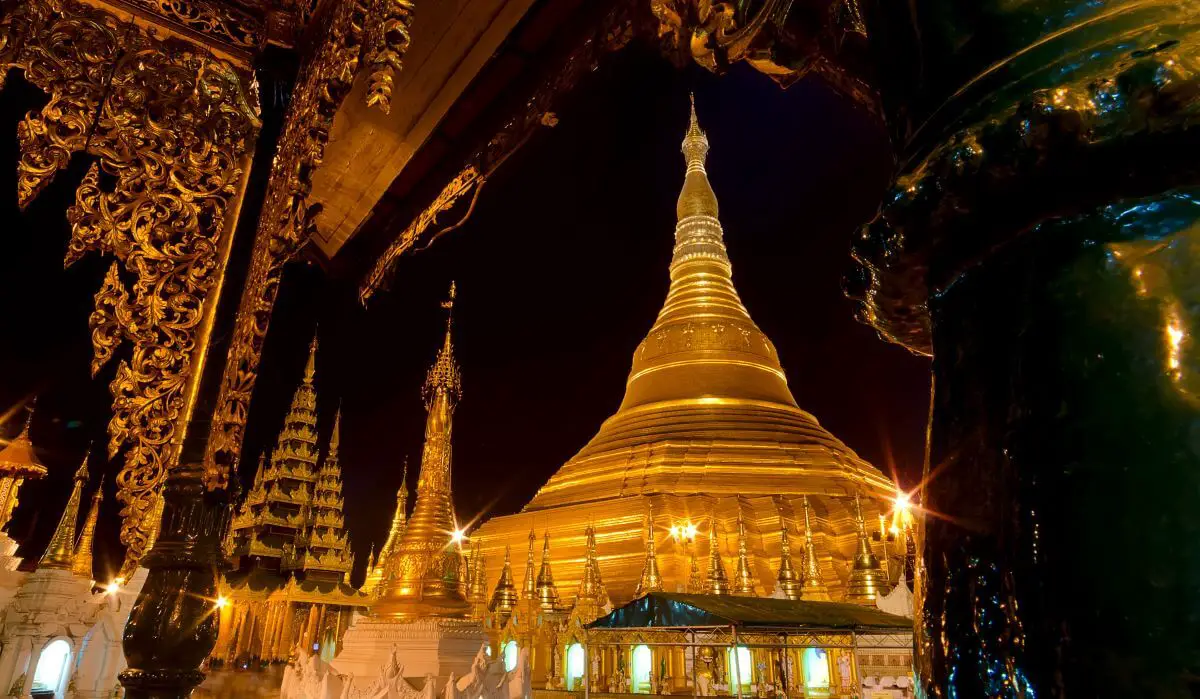
Yangon’s Shwedagon Pagoda is an unforgettable experience and is undoubtedly the most impressive Pagoda anywhere in Asia. Also known as the ‘Great Dagon Pagoda’ or ‘Golden Pagoda’, this gilded stupa was built back in the 6th century, and is considered the most sacred Buddhist temple in Myanmar.
There are four entrances at the cardinal direction points to the Shwedagon Pagoda. Chinthe, giant mythical lions, guard the entrances to the stairways that lead to the central platform. Atop this platform is the Shwedagon pagoda along with hundreds of other pagodas, Buddha images and shrines, spirit stations, and meditation halls. These images and stations show the influence of Hinduism and the animist Nat Spirit cult upon Theravada Buddhism in Myanmar.
The Shwedagon is covered in gold plate and encrusted with precious gems. Approximately 22,000 gold bars cover the Pagoda. At the top of the Pagoda is a hti (which means ‘umbrella’ in Burmese). The hti is made from 2317 rubies, 5448 diamonds, and gold. The crowning diamond is estimated to be worth 3 billion USD.
The best time of day to visit the spectacular Shwedagon Pagoda is at sunset as the heat of the day begins to leave the marble tiles around the platform and the birds begin to circle the Pagoda.
Inle Lake, Nyaungshwe
Explored by Tan from Travel to Work
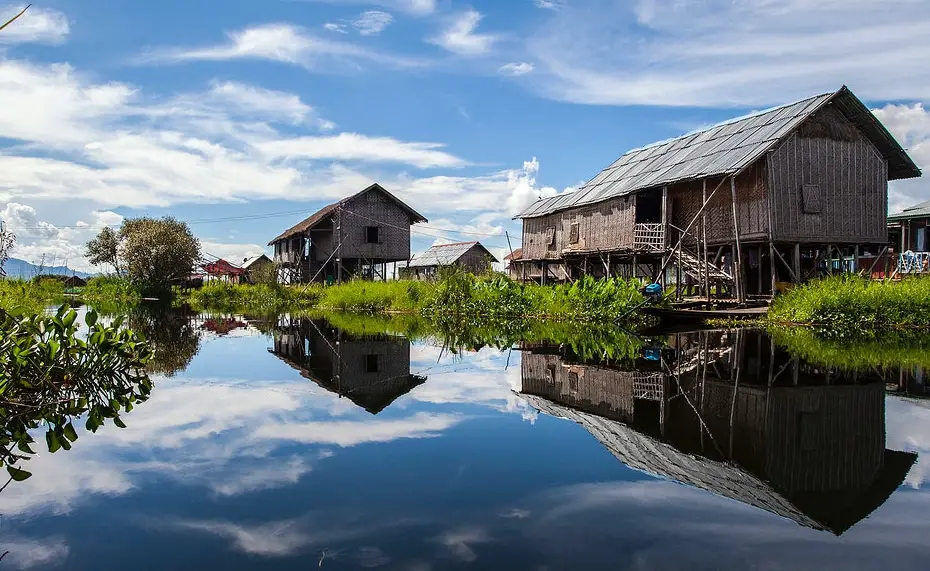
Situated in the picturesque Shan State, Inle Lake is a very enchanting destination. The second largest lake in Myanmar at 116.3 km², it offers countless photo opportunities from stilt villages to floating gardens, from exotic Buddhist relics to amazing mountains.
Probably the largest drawcard are the ‘Inthas’, the native lake dwellers and fishermen who have a unique one-legged rowing technique that you can’t see anywhere else in Asia. The area is also known for its distinctive markets including the floating market in Nyang Oo town where people trade produce from one boat to another, and the rotating market near Indein commune.
Amongst the best places to visit in Myanmar, Inle is probably the best spot to experience the ethnic diversity, as on a standard boat trip you can meet the Padaung, Pa-O, Intha and the famous long-neck people. The area is also known for its delicious food as the Shan State is well-regarded for it’s cuisine. From delicious noodle soup to crunchy cakes, from tofu salad to tasty fish dishes, there are a lot of delightful dishes to explore in Inle Lake.
Hsinbyume Pagoda, Mingun
Explored by Darren & Lauren from Faramagan
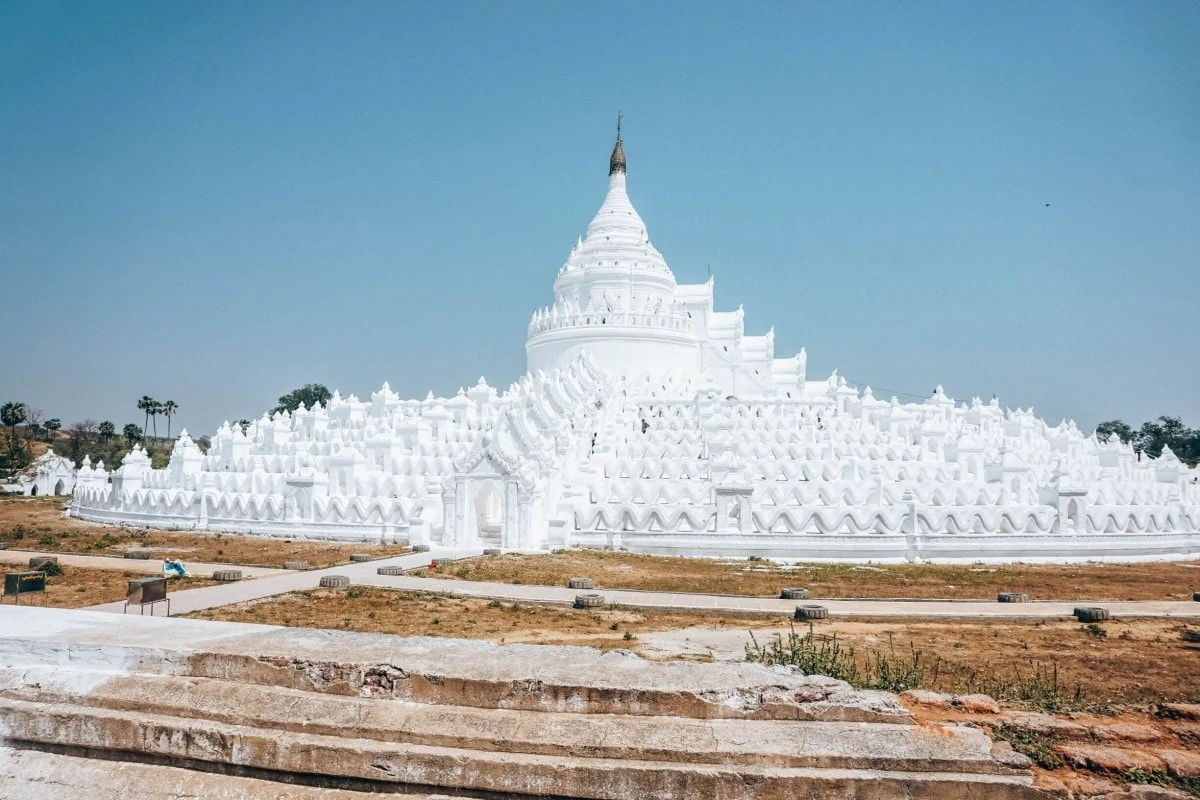
If you are visiting Mandalay, a day trip to Mingun is unmissable. Here you will find one of the country’s most famous landmarks – Hsinbyume Pagoda. The journey to Mingun is as exciting as visiting the pagoda itself. It involves catching the 9am ferry from Gaw Wein Jetty to Mingun where you can relax onboard for an hour, admiring local life on the water.
Then after purchasing your Mingun tourist pass, you have a couple of hours to explore the area before it’s time for the departure ferry at 12:30. As a tip, don’t get too distracted sightseeing and photographing the stunning sights as there is only 1 ferry there and back per day so if you miss it, you’ll be stuck in Mingun!
From the ferry drop off, it’s a pleasant 15 minute walk through the local village to Hsinbyume Pagoda, also known as Mya Thein Tan Pagoda. The pagoda was built as a token of love from prince Bagyidaw to his first wife, Queen Hsinbyume who sadly passed away during childbirth. Her name translates to Lady of White Elephant, which inspired the unique white colour of the pagoda.
Wandering up and down the many “layers” and through the endless arches was a definite highlight of our time in Myanmar. Each of the seven wave-like terraces represents one of the seven mountain ranges surrounding Mount Meru, known as the ‘centre of the universe’ in Buddhist theory – these distinguishing white arches make the pagoda very ‘instagrammable’, a fate which now puts the pagoda under threat.
Note: These pagodas have survived thousands of years and even earthquakes, but tourism and people walking across the layers is proving the greatest threat to their upkeep.
Kuthodaw Pagoda, Mandalay
Explore by James from The Travel Scribes
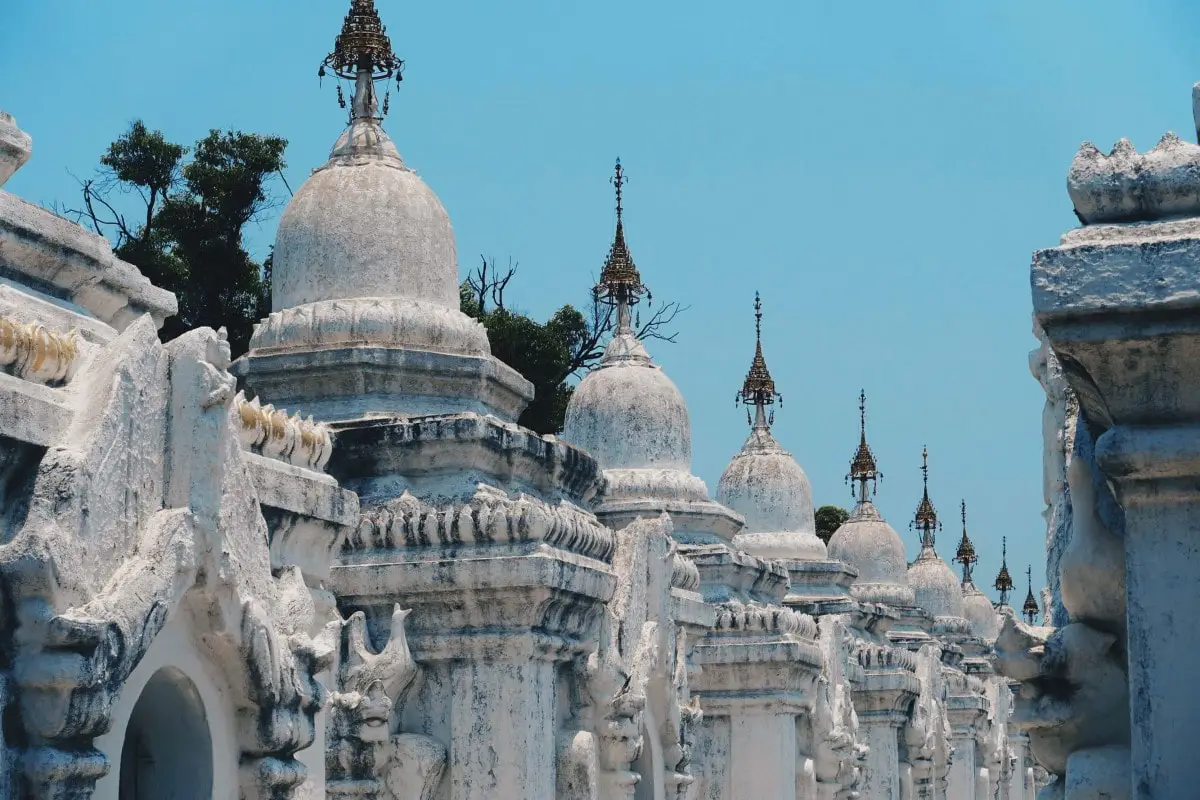
Built in 1857 by King Mindon Min, the Kuthodaw Pagoda is a sight for sore eyes. The solid gold exterior of this gorgeous temple is only rivalled by the interior, pristine white stupas that house 730 marble tablets, known to create the ‘world’s largest book’.
Each of the tablets is about five feet tall and five inches thick, covered in dense text which create the Tipitaka, essentially Buddhism’s religious canon. First unveiled to the public in 1868 the tablets used to boast golden ink as well as glittering precious stones like rubies and diamonds but unfortunately British troops looted it when they invaded in the 1880s.
So that is our list of iconic landmarks in Myanmar, what do you think? Let us know in the comments below or drop us a note here if you think we’re missing any in this travel guide!
And in case you are interested in checking out other landmarks – we have a number of articles about the most iconic places in Asia:
- 21 Iconic building and landmarks in Singapore
- Most iconic buildings and landmarks in Vietnam
- The ultimate Indonesia landmarks
- Thailand’s 21 most iconic places
- Iconic places and famous landmarks in Malaysia
- The most iconic landmarks in Sri Lanka
- Top 10 landmarks in China.
Want to save this for later? Why not pin it….
